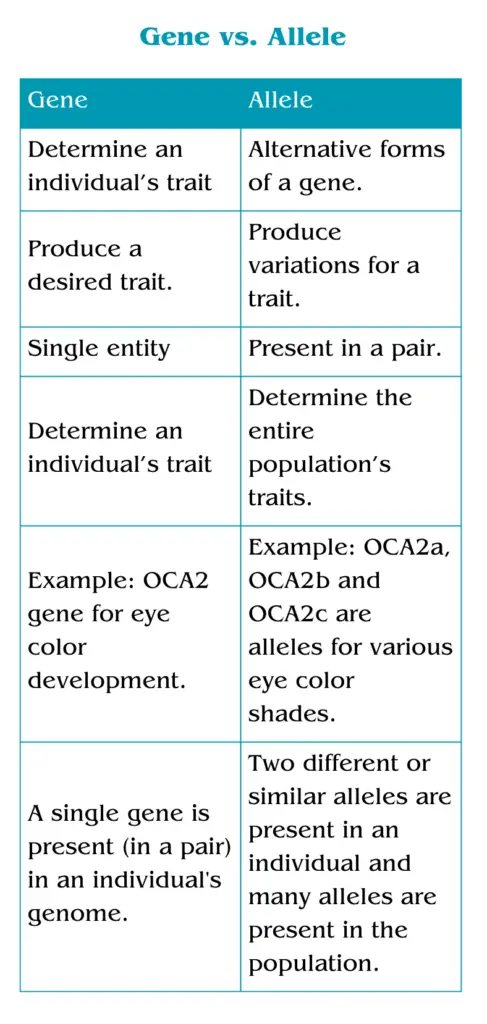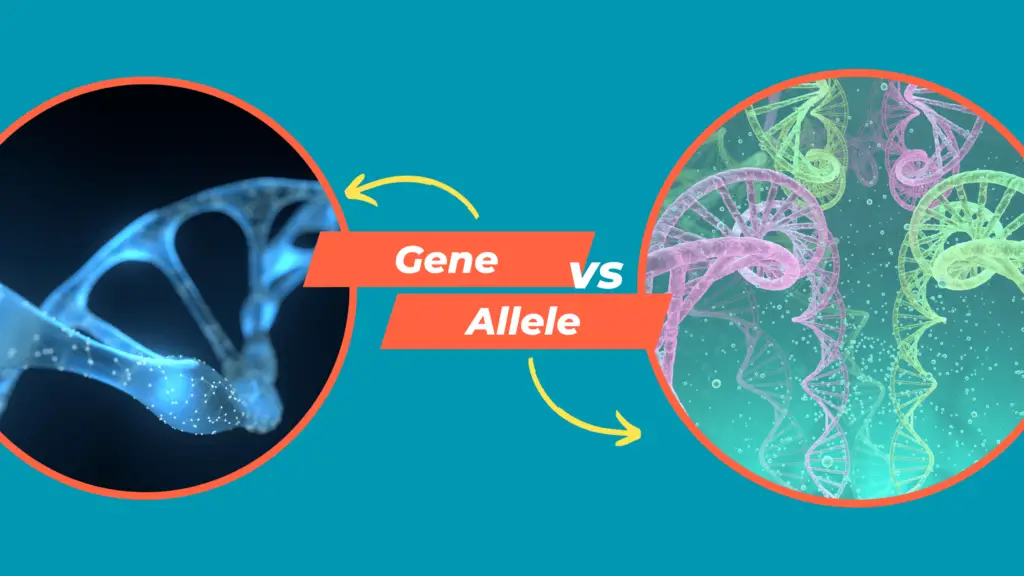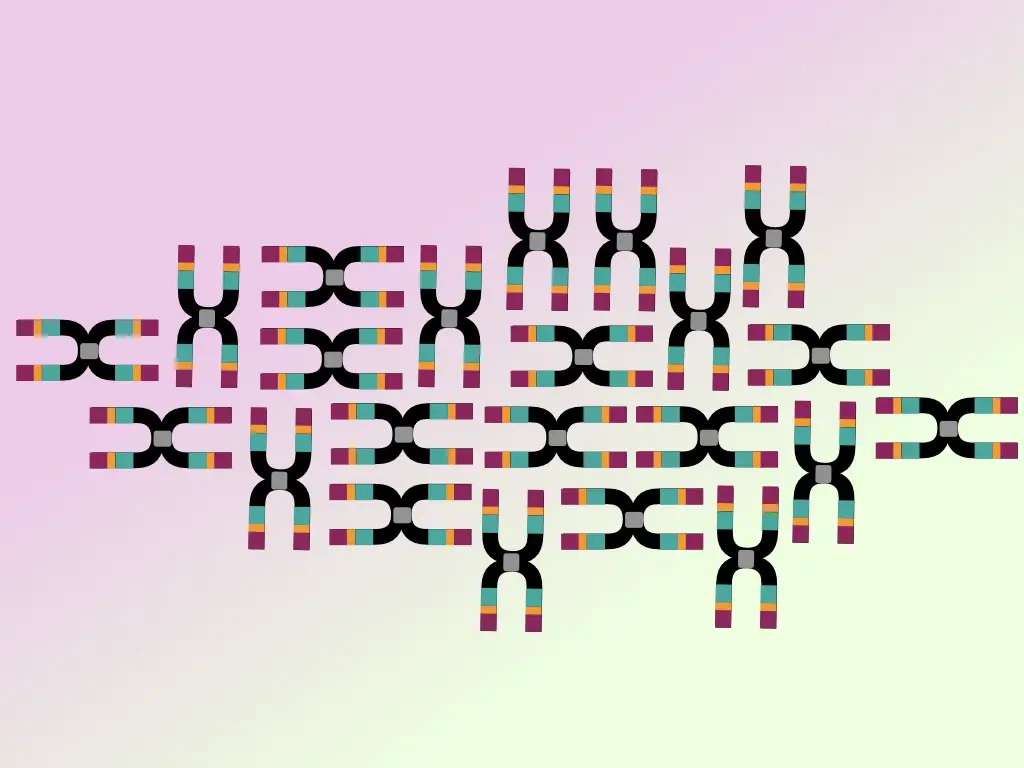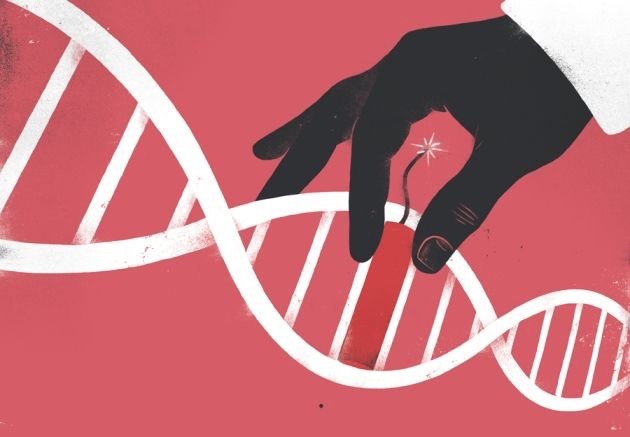“A Gene is a functional DNA fragment while alleles are alternative forms of a gene. Learn about the concept of genes, alleles and some of the differences between them in the present article.”
The ‘Gene’ part of our genome is only 3% and contains only 20,000 to 25,000 known genes. The rest of the ‘sequence ocean’ is just a non-coding part– unknown, huge and mysterious.
The basic function of a gene is to produce a protein, thereby, a specific trait. Genes are located on chromosomes, particularly talking, on the chromosomal arms. Because the telomeres and the centromere of a chromosome contain just repetitive sequences.
However, now it’s clear that non-coding DNA does participate in transcription and gene expression regulation. But the pivotal part is still– only genes! Because they encode enzymes, hormones, receptors, chaperones, immunoglobulins and any other protein you know.
You may wonder, there are millions of traits and billions of variations for those traits, how a few thousand genes make it possible! The answer is— by producing alternative forms, “alleles.”
Now, that’s something interesting, right? You may hear about alleles frequently if you are a student of life science, but perhaps, you don’t know— what exactly it is!
In this article, I will explain the concept of a gene, and allele and enlist major differences between gene vs allele. At Genetic Education Inc. We re-discover the knowledge and present it in the most interesting and understandable manner.
Stay tuned.
Disclaimer: Information provided here is collected from peer-reviewed resources and re-presented in an understandable language. All the sources are enlisted at the end of the article.
Related article: DNA vs Gene– A comparison for Beginners.

Key Topics:
What is a gene?
A gene is a long polynucleotide chain and a functional DNA fragment. Structurally, it is almost similar to the rest of the DNA with slight modifications. A functional gene contains introns (non-coding sequences) and exons (coding sequences) tandemly.
The number of exons and introns varies from gene to gene. Besides, it also contains upstream regulatory elements for enzyme and factor bindings. Those help in proper replication, transcription and translation.
Related article: Differences and Similarities between Exons and Introns.
The ultimate function of a gene is to synthesize a protein. One particular protein can only be encoded by one particular gene. Genes are located on chromosomes and in the cell nucleus.
Notedly, membrane-bound organelles like mitochondria and chloroplast possess their own DNA and genes. To know more about the molecular structure and function of a gene, read this article: What is a Gene?
Examples of a gene are genes for eye color, hair color, height, metabolism, skin pigmentation, analytical thinking, cognitive skills and neuronal development, etc. To understand the concept keenly, we will take the OCA2 gene with us throughout this article.
The OCA2 gene is located on chromosome number 15 and is responsible for eye coloration.
What is an allele?
Alleles are the alternative forms of a gene. For example, if a gene regulates a trait for height, the variations of that gene regulate the long, short and medium height. Thus, for a particular gene, many alleles do exist. However, an individual only contains a pair of alleles.
The OCA2 gene is responsible for eye coloration, as aforementioned. Meaning, it encodes ‘a protein’ that governs the eye color development trait. But interestingly, many eye-color shades exist, worldwide. For example, black, brown, hazel and amber etc.
These variations are produced by alternative forms of an OCA2 gene. The mutation is the event, responsible for producing any alteration in a gene and thereby different alleles.
For example, OCA2 a, OCA2 b, OCA2 c and OCA2 d produce brown, green, black and dark hazel eye colors, respectively. In addition, combinations of these alleles produce many other shades as well.
Let’s comprehensively understand this concept by taking an example. This is just a hypothetical example. And I made it simple for you.
| Alleles | Eye color share |
| OCA2 a | Brown |
| OCA2 b | Green |
| OCA2 c | Black |
| OCA2 d | Dark hazel |
Now, to produce a desired phenotype, alleles are inherited in a pair. For a gene, one allele is located on one chromosome and another allele on another similar chromosome. For example, for the OCA2 gene, one allele— OCA2a is located on one chromosome 15 and another allele—OCA2b on another chromosome 15.
In progenies, one allele is inherited from a father while another allele is inherited from the mother. The trait developed in the progeny depends on which allelic combination is present in its cells.
As we said, for a gene, an individual in their somatic cells contains only two alleles– either both similar (homozygous) or both different (heterozygous). Individuals possess only a pair of alleles, however, in a population or different individuals many alleles for a gene do present.
Differences between Gene vs Allele:
A gene is a specific DNA sequence that governs a particular trait, for instance— eye color. While alleles are the alternative gene forms that produce variations in that particular trait, for instance– differences in eye color.
Example of gene and alleles:
| Gene | Trait | Alleles | Trait variation |
| OCA2 | Eye color | OCA2a, OCA2 b, OCA2c, OCA2 d | Black, blue, green, brown eye color. |
| TRY | Skin color | TRY G>C, TRY G>A, TRY T>A | Fair, black, Ivory, sand skin color etc. |
| ABO locus | Blood group | AA, OO, BB, AO, AB, BO. | AB+, AB-, O+, O-, A+, A-, B+ and B- blood groups. |
A single gene is reserved for a particular type of a trait while two different alleles in combination change in that particular trait.
Thus, a gene is represented as a single entity while alleles are represented as a paired entity. A pair of similar alleles is known as homozygous while a pair of different alleles is known as heterozygous. For instance– OCA2aa and OCA2bb are homozygous while OCA2ab is a heterozygous pair of alleles.
Genes are present in all organisms, however, allelic variation vary; depending upon many factors– for instance, geography, location, ethnicity, atmosphere, etc.
Broadly, genes determine individual traits while alleles determine the entire population’s traits by bringing diversity to the population. Meaning, genes produce traits in an individual while alleles produce trait variations in the entire population.
Therefore, we can say, that genes are characteristic of an individual while alleles are the characteristics of the population. For instance, the OCA2 gene governs an eye coloration trait while the OCAa allele is responsible for brown eye color in the US population.
Genes remain conserved throughout evolution. Timely, evolutionary forces produce mutations in genes and create new allelic variations. For instance, the OCA2 gene has been present on earth for millions of years but various alleles have evolved timely in different organisms and human populations as per the requirement.
Mutant Gene vs Mutant allele:
Now, we can’t differentiate concretely the mutant gene and the mutant allele separately. When a mutation occurs in a gene, it produces another allele while a mutation in an allele also produces another allele.
| Gene | Allele |
| Determine an individual’s trait | Alternative forms of a gene. |
| Produce a desired trait. | Produce variations for a trait. |
| Single entity | Present in a pair. |
| Determine individual’s trait | Determine the entire population’s traits. |
| Example: OCA2 gene for eye color development. | Example: OCA2a, OCA2b and OCA2c are alleles for various eye color shades. |
| A single gene is present (in a pair) in an individual’s genome. | Two different or similar alleles are present in an individual and many alleles are present in the population. |
Wrapping up:
I guess I covered almost all the points that differentiate gene vs allele, certainly. These are basic terminologies of genetics. To learn various concepts of genetics, one has to understand these topics effectively.
Mutation is a crucial form, since life’s evolution on earth for producing variations, thereby alleles in different organisms and human populations. We know that mutations often produce harmful consequences. But trust me, nature produces alterations for our survival.
I hope you like this article. I have written other interesting articles like this, you can check that out as well.
Subscribe to our weekly newsletter for the latest blogs, articles and updates, and never miss the latest product or an exclusive offer.



